Master Recipe from “New Healthy Bread in Five Minutes a Day” using Vital Wheat Gluten!
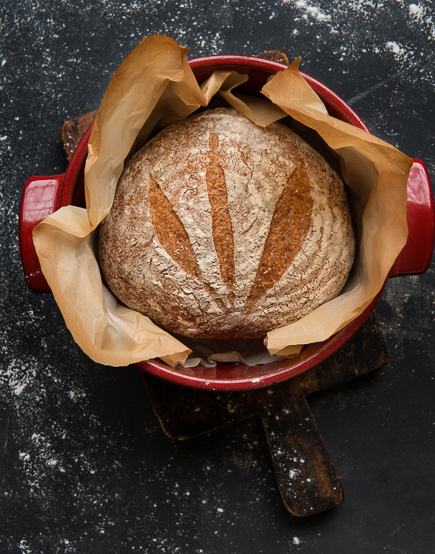
(The pictures in this post are by Stephen Scott Gross, who did the photography For New Healthy Bread in Five).
After writing the first edition of Artisan Bread in Five Minutes a Day in 2007 I was immediately asked how to convert the recipes to whole grains, and maybe even gluten-free equivalents. Through quite a lot of other adventures, the updated version has come out: The New Healthy Bread in Five Minutes a Day: Revised and Updated with New Recipes.
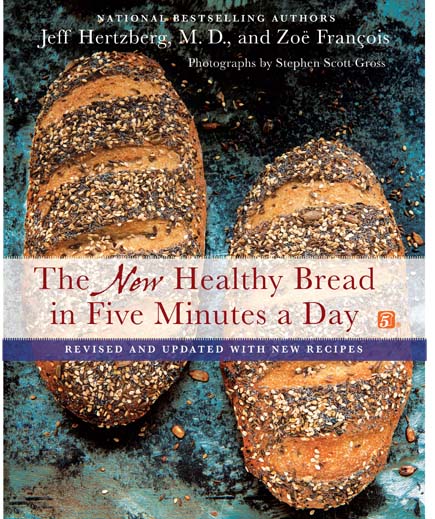
There are more photos to inspire you and make baking easier, all the recipes are in cup measures and weights, since we love baking with a scale and we’ve added charts for different kinds of flour, since there are so many on the market to choose from. And there’s a vast chapter of tips and techniques. Here’s a summary of what’s new in the new edition:
- Using sourdough starter as a leavening agent: for the first time in any of the books, instructions on creating your own starter and then using it as the leavening agent for homemade bread. Yeast bakers still have our original instructions as well.
- Weight equivalents for every dough recipe. Weighing’s more accurate and it’s catching on in the U.S. We’ve really made leaps and strides as a baking country since 2007 (when the first book was launched), because inexpensive digital scales have become available everywhere.
- Versions and options for omitting vital wheat gluten: Some of our readers asked how they could omit this from the recipes in the original Healthy Bread in Five Minutes a Day—which all called for added gluten. I’ve done that for the Master Recipe, and given some rules of thumb for doing it for the rest of the book as well (it’s a water adjustment).
- Using offbeat or ancient grains like spelt, Kamut (khorasan), and sprouted wheat: New rules of thumb for water adjustment when you use alternatives to standard supermarket whole grain flours.
- Other new ingredients that have started appearing in American pantries: Coconut and flaxseed oils work great in the recipes calling for oil.
- A gluten-free chapter: It has all the favorites from the book’s first edition, based on positive feedback from readers.
Now let’s dive into our Master Recipe, which didn’t change much, because it works so well and it is a great place to start for people who aren’t used to baking with whole grains. With whole grain baking you need more water, and one extra ingredient called Vital Wheat Gluten (sometimes labeled “vital wheat gluten flour”), which is available in most supermarkets, or mail-order/on-line from anywhere…
Whole grains can make for a drier results; all that bran soaks up water. So we increased the water for all the new recipes. But that was only part of it. I found that boosting the gluten content with vital wheat gluten increased the amount of time we can store the dough. Storing the dough is why these recipes are different from all others and makes baking so fast. Vital wheat gluten makes whole grain dough springy enough to be stored in the refrigerator as a large batch. There’s also a version without vital wheat gluten in the book for those who prefer not to use it or can’t find it.
What is vital wheat gluten? It’s the protein-rich part of wheat that creates the strands that trap gas bubbles and allow yeasted bread to rise (and stay risen). It doesn’t take much vital wheat gluten to make a difference in a 4 to 5 pound batch of whole grain dough. Just 2 to 4 tablespoons are all you need, so while the whole bag or box may seem expensive, it doesn’t add much to the cost of baking.
So where do you get vital wheat gluten? Most supermarkets in larger towns and cities carry it. The two brands in U.S. supermarkets are Bob’s Red Mill and Hodgson Mill, and we tested those extensively. If your local store doesn’t carry vital wheat gluten, you can mail-order it from Amazon; click for either the Bob’s Red Mill product, or the Hodgson Mill product (you can also order directly from those company’s websites).
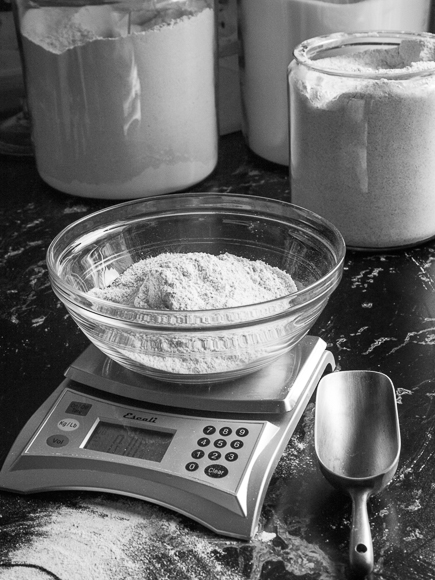
Master recipe from The New Healthy Bread in Five Minutes a Day:
There are many, many more details are in the book, along with plenty of recipes that are 100% whole grain; this recipe is about 73% whole grain:
Ingredients:
5 3/4 cups (750g) whole wheat flour – This is based on typical supermarket whole wheat, but we have a chart in the book so you can easily bake with King Arthur, Bob’s Red Mill, Sprouted Wheat, Kamut, Einkorn, Spelt or Hodgson Mill.
2 cups (300g) unbleached all-purpose flour
1 tablespoon (10g) granulated yeast – can decrease. You can use any kind of yeast including: instant, “quick,” rapid rise, bread machine, or active dry. You can also decrease the amount of yeast in the recipe by following the directions here. Or you can bake with a sour dough starter, see instructions here.)
1 tablespoon (15g) Kosher salt – can adjust to taste or health concerns
1/4 cup (40g) vital wheat gluten (or vital wheat gluten flour) – Here is a version without vital wheat gluten
4 cups (910g) lukewarm water (about 100°F)
1 to 2 tablespoons of whole seed mixture for sprinkling on top crust: sesame, flaxseed, caraway, raw sunflower, poppy, and or anise
To make the dough:

First, measure the dry ingredients into a 6-Quart Round Container or bowl, and whisk them together (you can also use a fork, or if it’s lidded, just shake them well). Mixing the dry ingredients first prevents the vital wheat gluten from forming clumps once liquids are added.
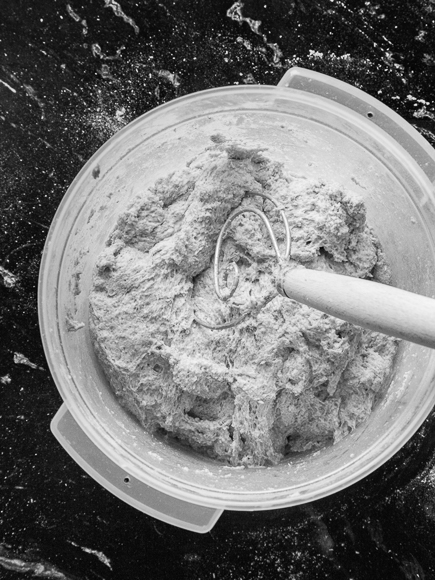
Add the water to form a wet dough and mix with a Danish Dough Whisk or wooden spoon.
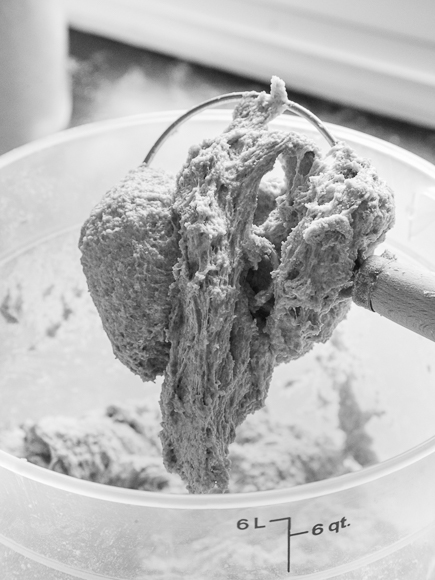
Don’t add additional flour to dry this out. It should be wet and shaggy.
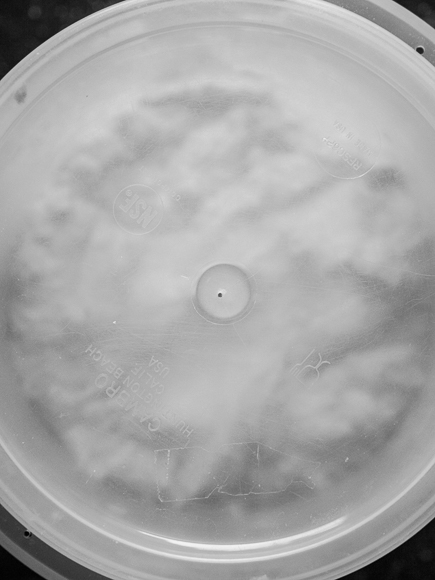
Cover loosely (leave lid open a crack) or you can piece a small hole in the lid, as you see above. Allow to rise for two hours at room temperature (if you decreased the yeast, you’ll need more time). NEVER PUNCH DOWN. The dough will rise and then begin to collapse. Refrigerate and use over the next 14 days, tearing off one-pound loaves as you need them.
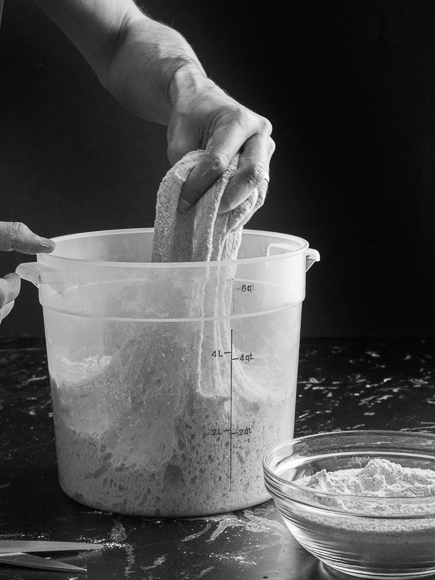
On baking day, cut off a grapefruit-sized piece of dough (about a pound), using a serrated knife or a Kitchen Shears.

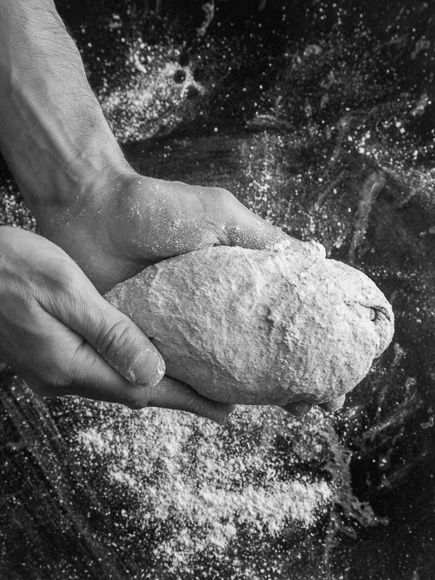
Quickly shape a loaf as you’ve seen in our videos on this website.
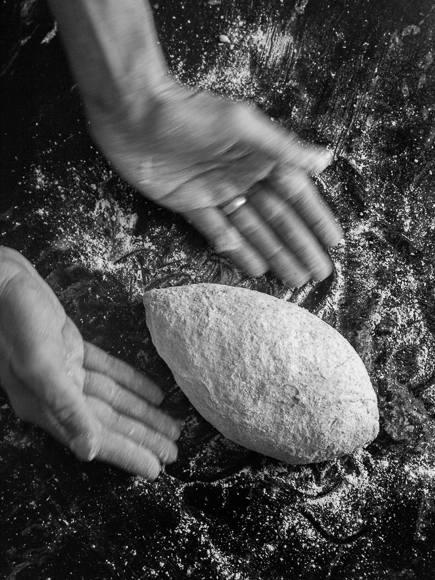
It should take less than a minute— you pull the top around to the bottom, rotating quarter-turns as you go. DON’T KNEAD or otherwise knock all the gas out of the loaf.

Cover the loaf loosely with plastic wrap and let it rest on a pizza peel covered with cornmeal or parchment for 90 minutes (40 minutes if you’re using fresh, unrefrigerated dough.) Depending on the age of the dough, you may not see much rise and it may spread out. The bottom loaf in the photo is just after shaping and then the one above it has rested and is ready for baking. Our loaves depend more on “oven spring” for rising.
Preheat the oven to 450°F (230 degrees C), with a baking stone placed on a middle rack. Place an empty broiler tray for holding water on any other rack that won’t interfere with rising bread.
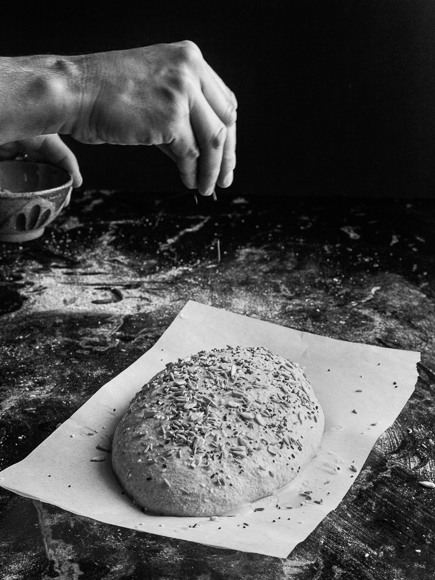
Just before baking, use a pastry brush to paint the top with water (we’ve dropped the cornstarch wash) and sprinkle with seed mixture.
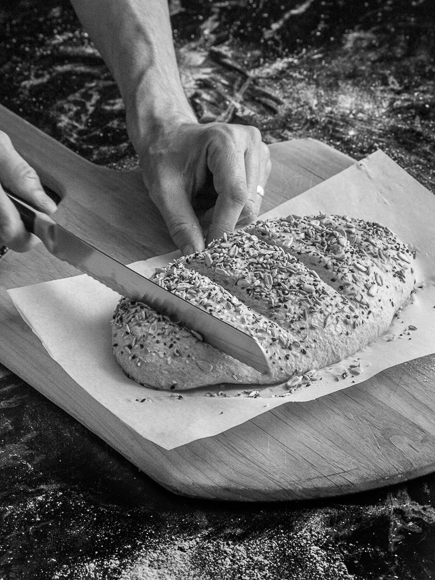
Slash the loaf with 1/2-inch deep parallel cuts across the top (or a singe lengthwise cut as in the first picture). Use a serrated bread knife held perpendicularly to the loaf:
Slide onto the hot stone…
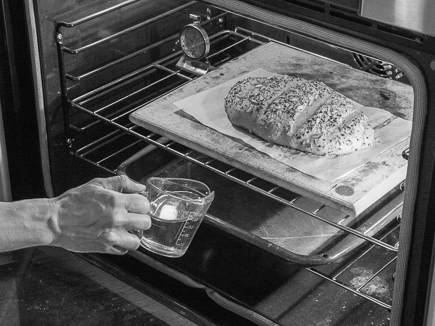
…and carefully pour 1 cup of hot tap water into the broiler tray (in the book, we give alternatives for creating that steam environment, which is essential for creating a great crust):
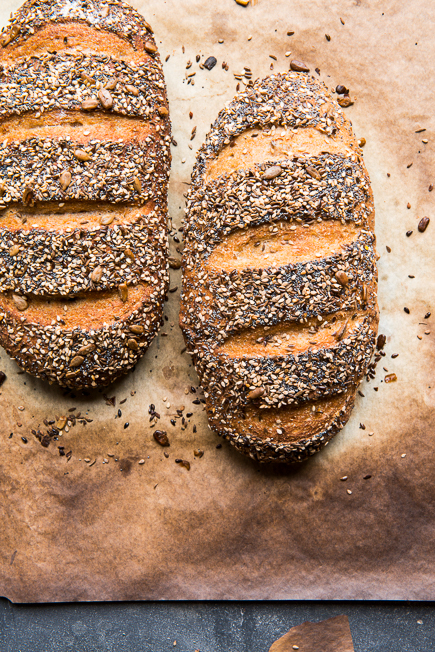
After a 30-minute bake, cool on a cooling rack.
Here are more shapes and ways to bake our Master recipe:

Slow Cooker bread from our Master recipe

Master recipe baked in a Cloche
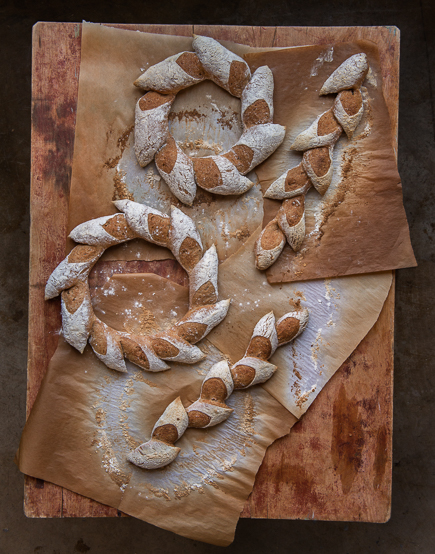
Epi and wreath from Master recipe
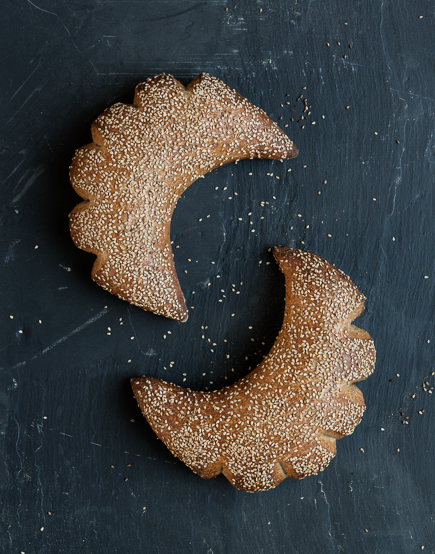
Moon and stars made from Master recipe. And there are many more in the book, plus 100 other recipes.
Note: BreadIn5.com is reader supported. When you buy through links on the site, BreadIn5 LLC earns commissions.
We’re going to be cruising on our sailboat and would like the capability of continuing to make bread. The boat has very limited refrigerator space so I was thinking of placing the dry ingredients for single loafs in gallon freezer bags. I could then mix them with water in the freezer bags and make individual loafs. Would appreciate your opinion.
Thanks,
Andy
We’ve done exactly this for kids’ school projects, yes!
Can I add honey to this recipe? If so, how much?
Thanks.
One option is on page 80 of the book, the variation at the bottom of the page. The book’s on Amazon at https://bit.ly/3wYSSN
Hi,
I went with Jeff’s suggestion to me in the Ask a Question thread and picked up a Kindle copy of “Healthy Bread in Five Minutes a Day.” I’ve made it as far as the Master Recipe, and I have question…
I’ve been baking the Master Recipe above, which I converted to weights using a spreadsheet of cooking conversions that I found some years ago. For water the sheet listed 1 cup = 236.588 ml, which matched my calculator’s constants and an internet search.
So when I got to, “4 cups of water,” I went with: 946 ml = 946g. I’ve been getting tasty bread, but with less rise and a somewhat more dense loaf than I was hoping for.
The table of ingredients for the Master Recipe matched all my conversions closely until I got to: lukewarm water 4 cups, 2 pounds, 900g.
So perhaps I’m using 5% more water then when you bake the Master Recipe, if you bake by the weights? Would this be enough to reduce my rise and oven spring? When I shape my boule and let it rest on the peel, I get a lot of sideways spread. Even before I slash it, there is less height at the end of the rest then when I first finished shaping.
Should I cut water back to 900g?
Thanks,
Alan
Yes, definitely– those don’t foot across perfectly, in an effort to get rounder numbers into the final recipe. Maybe 910 grams, but no more.
Thanks Jeff, I’ll cut back on the next batch and see how it goes.
I’ve got to restock on flour, so perhaps you can also help me with a tangential question. I can buy Gold Medal locally for about $2 less per bag than King Arthur. I want to use unbleached, unbromated flours, but neither the Gold Medal nor the General Mills web sites provide full information.
There is a GM all-purpose labelled unbleached, but it doesn’t call out unbromated. The GM white whole wheat doesn’t call out either unbleached or unbromated. The only flour labelled as both is Better for Bread, but I don’t need bread flour for the Master Recipe.
Since you and Zoe have been to the mill, test kitchens, etc., I’m hoping you’ll have more information. Has Gold Medal stopped bromating their consumer flours (if they ever did)?
Thanks again,
Alan
When we visited, GM said that they are also unbromated. I don’t know why they don’t tout it. This was an informal conversation, you may want to check directly with the company as well, at GoldMedalFlour.com
Whole wheat flours are never bleached…
Here in the Czech Republic, we are used to wheat-rye bread. Can I that whole grain flour for rye flour? Will it need any other adjustment of ingredients?
Thanks for your answer.
Rye has less gluten and it’s whole-grain version absorbs a lot of water. In this particular recipe, substituting rye flour for wheat flour is going to result in a very, very dense bread, and you’d need to increase the water (?? how much). We have a rye version in the book this comes from, it’s on Amazon at https://bit.ly/3wYSSN. We have some basics about rye here on the website, which you can see if you type “rye” into our Search Bar above.
Just made this for the first time. My dough sat in the fridge for a few days before baking and when I went to form the loaves the top of the loaf was very holey. What am I doing wrong?
Hi. Do you mean it looked like there were bubbles in the dough that popped on the surface or is it something else?
Thanks, Zoë
is it possible to decrease or maybe completely remove the amount of white flour in the recipe? my ideal situation would be 100% whole grain.
Itay
We have a number of 100% whole grain recipes in the book that this recipe comes from (on Amazon at https://amzn.to/1msOBmY), but you can’t just swap it in– there’s a water adjustment.
Thank you for this recipe! I own your first book, which I love. Made up several bags of this healthier version by milling our own flour, adding the rest of the ingredients, and putting each bag in the freezer. When we are ready for some bread, we just pull out a freezer bag, add water, mix it up, let it sit for 2 hours, and bake. So simple!!
Hi Leah,
Thank you for the wonderful note, we are so glad you are enjoying the bread!
Cheers, Zoë
Can you make pizza with this dough?
Hi Lucy,
You sure can.
Enjoy, Zoë
Hi, I just got your healthy bread book and I love it! I am planning on making the caramel sticky rolls using this dough. Can I do the second rise in the fridge overnight? Would like to have the rolls first thin in the morning if possible!
You can, yes. See the Refrigerator Rise Trick under the FAQs above.
Have a question about whole wheat bread. I have tried them now 3 Times but bread doesn’t get as fluffy as the white bread. White bread turns out always great but not so with whole wheat and I don’t know what I’m doing wrong. Bread is a lot denser than white but I’m following your recipe to the T. Please help.
Hi Maggie,
Whole grain bread is denser than the white bread, just the nature of the beast. But, it shouldn’t be overly dense. Tell me a bit about the flours you are using.
Thanks, Zoë
Hi Jeff,
I love your master whole grain recipe! I’ve tried also making it with einkorn flour but the dough seemed too wet. The final boule went flat in the oven. The bread seemed fluffy, not dense, just spread on me like a flat bread (1.5″ high). Should I use less water?
Hi Justyna,
You’ll want to use the spelt recipes in the book when using einkorn. It doesn’t have as much gluten developing protein, so it requires less water than all-purpose flour.
Thanks, Zoë
Thank you Zoe. Is the spelt recipe in your “Healthy Bread in Five Minutes a Day”?
Hi Justyna,
Yes, that is exactly right. If you want to play with other recipes, you’ll need to decrease the amount of water and I’d start with a small batch, until you get the bread you like.
Thanks, Zoë
Since there’s a 90 minute resting time for this bread, would you recommend a 30 minute or so resting time if putting it in the crock pot to bake? Or do you think it would come out fine straight out of the refrigerator after shaping/gluten cloaking?
(I actually have a loaf in the crock pot now, and it’s been in for… close to 2 hours now, I think, and I didn’t do a rise beforehand, and it’s a little hard to tell when it’s done without being tempted to cut into it.)
It took a little over 2 hours (with peeking about every 15-20 minutes after the first 60). Not what I was expecting, but good. I was surprised how much my kids loved it, and it was great for a salamo sandwich with mayo.
*Salami sandwich. 😉
Well, our idea here was to minimize the waiting times and just be done with it. It won’t hurt to do it as you suggest.
I ordered the book and it arrives this Tuesday. looking forward to it. I’ve tried recipes from the old version and it taught me this whole new approach to baking.
Hi Karen,
Thank you, I really think you will enjoy it!
Cheers, Zoë
Love the new website!
Thanks!
When I take some dough out to bake, can I just replace it with more flour and water and keep the dough going in the fridge, kind of like feeding a sourdough starter?
Hi Sherri,
We recommend that you wait until there is about a pound or less dough and then add the ingredients for a new batch. This jump starts the flavor of the next batch. https://artisanbreadinfive.com/2015/05/20/fresh-bread-made-with-older-dough
Thanks, Zoë
Can the master recipe be stored in a stainless steel bowl?
Hi Glenda,
Yes, you sure can!
Cheers, Zoë
Hi Zoe! Thanks for getting back to me re: storing in stainless steel bowl. I did have a 3 qt plastic container, by the time the dough finished rising it looked like the hat on the Pillsbury dough boy, way over the top! Have already ordered 5 qt container. Just wanted to let you know that I made my first loaf of artisan bread in 5 yesterday exactly as recipe indicated, and it was PERFECT! My husband and I couldn’t get over how nice and crisp the crust is, and loved the taste and texture of the bread. I will be making another loaf today, and I am also looking forward to trying the healthy bread in 5. Many thanks to you and Michael for taking the time and effort to perfect this recipe and make it available to all of us!!
Hi Glenda,
I am so pleased that your first loaf was such a success. I have had the dough pop over the top of a container, so you are in good company!
Cheers, Zoë
P.S. I also ordered your New Artisan Bread cookbook…can’t wait to try the recipes.
Jeff & Zoe
I Love, Love, Love your books. I have 4 of them. Just received your latest for a Christmas gift. Yea!!!!
I love working with your dough recipes.
I have a question about which type of dough would be best for making runzas or bierocks. Most recipes I have seen that are posted, are made with an enriched dough with egg, sugar and milk. That is fine, but I would like to make a big batch of dough to be able to use as needed and could keep in the fridge . Any suggestions would be appreciated.
Thanks.
Our brioche (richer) or challah (less rich) would be very close to what you’re looking to do. Five days are the max storage though, otherwise freeze it.
Thanks for your speedy response
. Going to start the dough today.
Can you make pita bread with this recipe?
Yep, it’s in the book!
Love your new book but help, please! The Honey Whole Wheat variation of the 100% Whole Wheat master recipe says 350 degrees for the baking temperature ON PAGE 92, but 450 degrees for the baking temperature ON PAGE 95! WHich is correct, please?
So sorry, in my question above I meant that it says 450 degrees on PAGE 97 for Honey Whole Wheat but 350 degrees on page 92
We ask you to “correct the baking temperature as directed in the variation you’re using.” So the variation-temperature, on page 92 is correct. Page 97’s instructions would hold only if you were using the basic dough.
Thank you very much for your fast reply! I see now.
(It is a bit confusing in the book, however, because while it does say on page 96, “Correct baking temperature as directed in the variation that you’re using” [sorry; I missed that], the Honey Whole Wheat variation is the only variation on pages 92-93 that has a different temperature in its description.)
… point well taken. So many details in cookbooks, and you never quite know how something will read.
From your website, the “with vital wheat gluten recipe (73% whole grain) and
“New Healthy Bread in 5”, an opinion please on adding the barley malt powder and malted wheat flakes to it, referenced in the English Granary Style recipe on page 156, “New Artisan Bread in 5”. Thanks!
Hi Kathleen,
I think it sounds like a great idea. Neither of those ingredients will absorb much water, but you may need to add a tablespoon or two to get the right consistency. I’d start with a small batch to make sure you like the results.
Thanks, Zoë
Is it possible to convert this beautiful loaf of bread to low-carb, replacing the unbleached and whole wheat flour?
And not loosing the chewy, yeasty taste?
Truthfully–no. All you can do is convert to 100% whole wheat–and the carbs will be marginally lower. But bread like this is still a high-carb food. Conversions to 100% whole wheat are in our book, at https://amzn.to/1NdVkgj
Hi – I like to bake with King Arthur *White* Whole Wheat flour, but I see in the book you only have conversion for their regular whole wheat flour. Since the weight for the two flours is the same at 113g/cup, do you think I would be safe following your recommendations for the regular KA whole wheat? It looks like quite a bit more water than the master recipe, but the white whole wheat is more delicate. I’m planning to make the master recipe that includes the AP white flour as well. Thanks, and thank you for a wonderful book!!
Rhonda: That’s exactly how I’d do it. KAF WW and WWW should measure and absorb about the same.
Have you ever or could you use raw gluten instead of vital wheat gluten powder?
Hi Jo,
I’m not familiar with raw gluten. Can you describe it to me?
Thanks, Zoë
To make it you select your flour.
Make a simple water and flour dough. Knead for a while. Then lest it rest in a bowl of water for an hour.
Then you rinse all the starches out inder running water starting with warm water slowly getting colder.
You end up with raw gluten
Here’s a similar method that describes in more detail.
https://www.leaf.tv/articles/how-to-make-vital-wheat-gluten/
Hi Jo,
I have never heard this referred to as raw gluten, I’ve always called it seitan. Once you have created this with the wheat protein, it is much too rubbery to blend into a dough, so you need to use the powder form of wheat gluten.
Thanks, Zoë
Hi, I have your 1st 2 books (original editions), and have swiched in the last year to local flours, with perhaps a coarser ground. (Am also in Canada). Have figured I need to add more water, but I still have a hard time getting a crumb that is not crumbly near the top in whole grain breads (am experimenting for a softcrust 50/50 loaf without eggs). Any insight? More gluten flour?
Canadian flours are higher in gluten, so they take more water–sounds like you’re experimenting with that. A quarter-cup extra per batch? But then there’s the pesky problem of local flour, local grinding methods, and local variations in how long it’s stored and dried before grinding. So all bets are off–you may need more than a quarter cup—but you may need less. Gut feeling: more (because you say it’s crumbly).
Consider longer resting times, may help the coarse grain absorb water. A little oil or butter? Quarter cup? Could help bind it together.
Last night’ s test came out nice, with butter and honney @375 F , not crumbly and nice hole strucure, but crust was like a cookie (not hard though). I bake on a stone with an upside down stainess steel bowl to get a cloche effect, and always preheat the stone 50 degrees over target temp. I aso sometimes raise the loaf on warming oven. Noticed it cracked the gluten cloak yesterday, maybe I shouldn’t rest it on the oven… I also tried shaping it a bit longer to get a better cloak, as I saw you suggest this to sb else.
After spending time in a plastic bag, crust is exactly what I’ve been looking for!
Fantastic!
I am making the master recipe from page 89 of the Healthy book but my dough just comes off in a chunk (not stretchy like the pic) after refrigeration. I am measuring all ingredients using a scale and mixing in a Cambro tub with a danish dough whisk. I saw on your blog about the regular artisan bread that if the dough breaks off instead of stretches, it may be too dry, but that is not the case. My dough is very wet. Any ideas? Or is the whole grain recipe “less stretchy?”
It’s definitely less stretchy, because the sharp bran bits cut up the developing gluten strands. But the real question is what you think of the fully-baked loaves. Are they tasty and with proper texture? Hard/tough? What brand of flour are you using?
And to confirm which book, is page 89 the Rosemary Flax Baguette? (that’s our first edition of that book). It does have wheat germ and flax, which is not the dough we photographed for the book. For that, we used Chapter 5’s Master Recipe, which is definitely stretchier.
Hi I am wanting to make the master recipe from The New Artisan bread in 5 minutes a day. The flour I buy is wheat Montana prairie gold 100% whole wheat flour. It’s a white whole wheat. Serving size is 38g and protein is 5g per serving that breaks down to 1.9% protein. Will it still work? How should I adjust the water?
Hi Johni,
The Master recipe is formulated for all-purpose flour, so your bread will end up too dry and won’t rise well. If you want to bake whole wheat breads, we have a few in that book, including 100% whole grain bread or you may enjoy our New Healthy Bread book, which includes many more whole wheat recipes.
White Whole Wheat behaves like whole wheat flour and not All-purpose flour.
Thanks, Zoë
Hi there! Love the AP 5 minute bread, so I wanted to try this one. The dough is a lot wetter and looser than anticipated. The whole wheat flour I’m using is a 20lb bag I got from a local farmer, and is definitely more coarse than store bought.
Hi Courtney,
The flour you have probably doesn’t absorb flour in the same way as commercially ground flour, so it will produce a wet dough. You will just need to add more flour or VWG, depending on which recipe you used. https://artisanbreadinfive.com/2009/11/11/using-fresh-ground-whole-wheat-flour-and-some-highlights-from-our-book-tour/
Thanks, Zoë
I have recently bought the New Artisan Bread in 5 Minutes A Day and the Healthy Artisan Bread in 5 Minutes a Day so am still learning. My white bread has been coming out fine but the master recipe for the whole wheat bread is not working as well. I have made it twice and both times when I take the dough out of the frig to shape it the dough tears. There is a little stretch, not much, before it tears. After the first time I figured it was hydration so for the next batch of dough I made I added extra water. I am using the recipe without the vital wheat gluten so was the first batch had the reduced water amount. For the second batch I added back in the full water amount but the dough is still tearing. I’m using Gold Medal flours (unbleached AP and whole wheat) and I weigh all the ingredients. Do you have any suggestions on what I can do to fix this problem? Thanks
Hi Cathy,
This could actually be a temperature issue. If your refrigerator runs a little cold, it will make the dough seem brittle. If so, you can just let the shaped loaf rest an additional 20-30 minutes and that should take care of the problem.
Let me know if that works! Zoë
That worked! It was a great looking and wonderful tasting whole wheat bread! Thank you.
Terrific Cathy,
Enjoy!
Hi.
Generally speaking, which will have a higher rise & more open crumb – 1 week or 2 week old dough.
1
Just stirred up two batches of the Whole Wheat Master recipe from the Healthy Bread book (copyright 2009). I used weights (grams) instead of measurements. I now have 2 bowls of wheat gruel on the table. Doesn’t come close to resembling dough.
So I came to the website and the recipe posted has different measurements and weights than the book. More flour, less yeast. Not sure I’m up to batch 3 or not.
I used to have a cheat sheet of corrections to the first book. Is there a cheat sheet with corrections for the original Healthy Bread in 5 book? And for the New AB in 5 book? If so, I’d appreciate receiving them.
If not, I’d like suggestions as to why I have two bowls of gruel rather than bread dough. The wheat was freshly ground which is why I chose weights rather than measurements. Used Dakota Maid AP Flour, Kosher salt and vital gluten, soft water — cannot think of any other variables that might be relevant.
Thank you.
Am in eastern SD so similar altitude to the Twin Cities. Not new to AB – bought your first book shortly after it came out and have been using the Master Recipe for years. Never had the gruel situation. I’ve always subbed 1 c of the AP flour for a whole grain in the past but decided to see how the Healthy recipe worked.
You can find corrections to all of our books at https://artisanbreadinfive.com/errors/, just click on whichever book you’re interested in. But your problem, I’m almost sure, relates to the use of home-ground flour. See my post on that for why this makes the recipes unreliable, at https://artisanbreadinfive.com/?p=1165 And we found the lower yeast-dose doesn’t make a difference in practice, and some folks preferred the flavor.
That said, there’s an easy solution–you just need to add more flour, until the dough looks like what’s in this video: https://www.youtube.com/watch?v=hDBJkxoNpE8 No need to throw away the overly-moist dough. And altitude isn’t the issue here in MN and SD.
Most important: did you use the vital wheat gluten? Otherwise you have to decrease the water–the VWG really absorbs it.
I just made this bread. I used whole white wheat flour and topped with Everything Bagel spice. It is delicious! I skipped the water in the bottom pan. It has a nice crust and is soft and chewy! Looking forward to the new book!
Fantastic Pam, so glad you’ve enjoyed it. Come back anytime with questions.
How do I half this recipe and use only sourdough starter
/
All of the recipes can be cut in half. Have you been to the Page in the website here on sourdough starter? Just type that into the search bar
I am using the gluten free recipe in your book. My dough will rise after I make the dough, but once I put it in the refrigerator for 24 hours and then take out a 1 pound ball and let it sit for 90 minutes and then bake it, it does not rise at all. Am I doing something wrong?
Are you making any swaps for any of the ingredients? The recipes were tested with Bob’s Red Mill, and not with any of the flour blends… Only with the mixture in the book. Which recipe exactly are you using, from which page number?
in your book “The New Healthy Bread in Five Minutes a Day” reference is made on page 77 to “altus” (see sidebar page 33)
There is nothing like that on page 33 in this book and altus is not listed in back index either and I cannot find anything related on what I have checked on your site.
Could you explain and define please and thank you?
Sorry about that, the page reference should have sent you to page 170, which is a pumpernickel loaf. But you can use the altus technique in other breads as well. I’ve added a correction at this page: https://artisanbreadinfive.com/errors/
Can you substitute white whole wheat flour for whole wheat flour?
Yes, you can. They measure and weigh comparably.